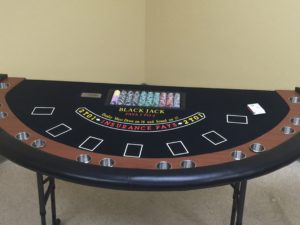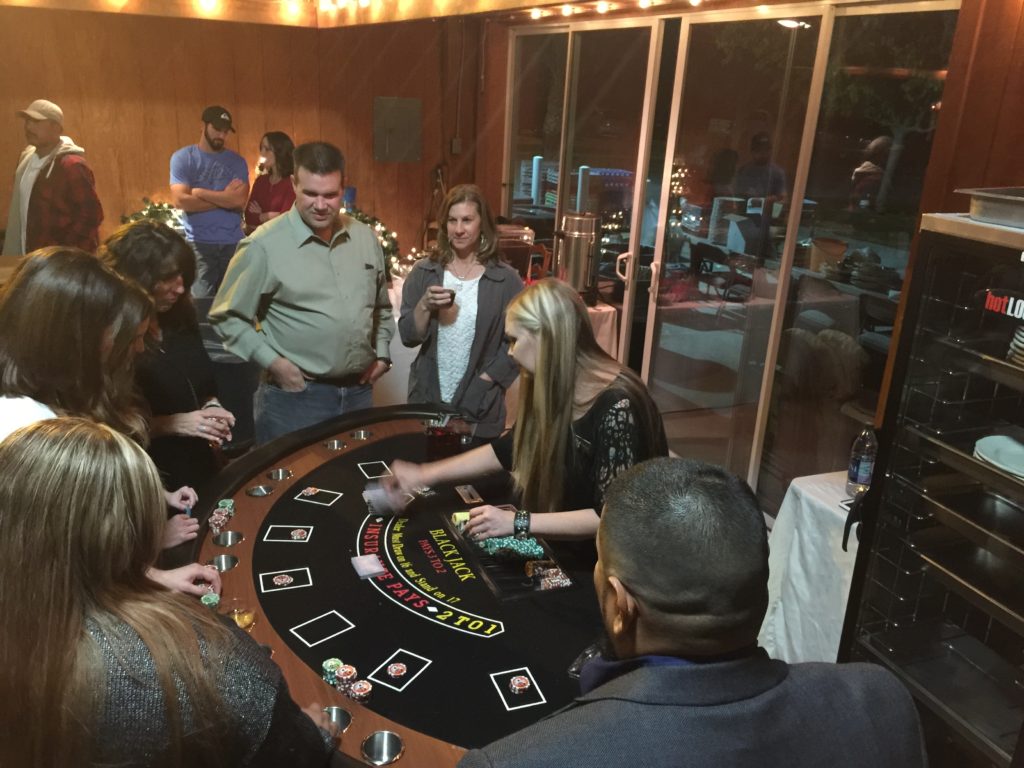 Blackjack, also known as twenty-one, is the most widely played casino banking game in the world. It is played with one deck of 52 cards.
Blackjack, also known as twenty-one, is the most widely played casino banking game in the world. It is played with one deck of 52 cards.
Our Blackjack tables will host 7 players at a time.
The object of the game is to beat the dealer, which can be done in a number of ways:
 Get 21 points on the player’s first two cards (called a blackjack), without a dealer blackjack;
Get 21 points on the player’s first two cards (called a blackjack), without a dealer blackjack;
Reach a final score higher than the dealer without exceeding 21; or Let the dealer draw additional cards until his or her hand exceeds 21.
as an added feature we can provide custom printed playing cards with your company name or logo on them.
Rental prices and Package information is available here!


“School of Gaming” How to play Blackjack
Gaming expert Barney Vinson and host Cheryl Maxfield deliver comprehensive, advanced instructions on how to play winning Blackjack.
The Wizard of Odds teaches his simplified blackjack strategy
The Five Most Misplayed Hands in Blackjack with Blackjack Expert Henry Tamburin
In this video, blackjack expert, Henry Tamburin, gives details on the five most misplayed hands. Some of the topics covered include: a pair of 9’s against a 9 or 10, 16 against a 10; 12 against a 3, soft 18 against a 9 or 10; and a pair of 8’s against a 10. Henry analyzes each hand and explains what the proper decision is for each situation.
Rules
“The object of blackjack is to get as close to 21 as possible, without going over.” No! The object of blackjack is to beat the dealer. To beat the dealer the player must first not bust (go over 21) and second either outscore the dealer or have the dealer bust. Here are the full rules of the game.
- Blackjack may be played with one to eight decks of 52-card decks.
- Aces may be counted as 1 or 11 points, 2 to 9 according to pip value, and tens and face cards count as ten points.
- The value of a hand is the sum of the point values of the individual cards. Except, a “blackjack” is the highest hand, consisting of an ace and any 10-point card, and it outranks all other 21-point hands.
- After the players have bet, the dealer will give two cards to each player and two cards to himself. One of the dealer cards is dealt face up. The facedown card is called the “hole card.”
- If the dealer has an ace showing, he will offer a side bet called “insurance.” This side wager pays 2 to 1 if the dealer’s hole card is any 10-point card. Insurance wagers are optional and may not exceed half the original wager.
- If the dealer has a ten or an ace showing (after offering insurance with an ace showing), then he will peek at his facedown card to see if he has a blackjack. If he does, then he will turn it over immediately.
- If the dealer does have a blackjack, then all wagers (except insurance) will lose, unless the player also has a blackjack, which will result in a push. The dealer will resolve insurance wagers at this time.
- Play begins with the player to the dealer’s left. The following are the choices available to the player:
- Stand: Player stands pat with his cards.
- Hit: Player draws another card (and more if he wishes). If this card causes the player’s total points to exceed 21 (known as “breaking” or “busting”) then he loses.
- Double: Player doubles his bet and gets one, and only one, more card.
- Split: If the player has a pair, or any two 10-point cards, then he may double his bet and separate his cards into two individual hands. The dealer will automatically give each card a second card. Then, the player may hit, stand, or double normally. However, when splitting aces, each ace gets only one card. Sometimes doubling after splitting is not allowed. If the player gets a ten and ace after splitting, then it counts as 21 points, not a blackjack. Usually the player may keep re-splitting up to a total of four hands. Sometimes re-splitting aces is not allowed.
- Surrender: The player forfeits half his wager, keeping the other half, and does not play out his hand. This option is only available on the initial two cards, and depending on casino rules, sometimes it is not allowed at all.
- After each player has had his turn, the dealer will turn over his hole card. If the dealer has 16 or less, then he will draw another card. A special situation is when the dealer has an ace and any number of cards totaling six points (known as a “soft 17”). At some tables, the dealer will also hit a soft 17.
- If the dealer goes over 21 points, then any player who didn’t already bust will win.
- If the dealer does not bust, then the higher point total between the player and dealer will win.
- Winning wagers pay even money, except a winning player blackjack usually pays 3 to 2. Some casinos have been short-paying blackjacks, which is a rule strongly in the casino’s favor.
Advice from wizardofodds.com
I’ve been preaching for years that to play blackjack properly requires memorizing the basic strategy. However, after pitching the basic strategy for 20 years, I’ve learned that few people have the will to memorize it. In my book, Gambling 102, I presented a “Simple Strategy,” which is seven simple rules to playing blackjack. The cost due to incorrect plays with the Simple Strategy is 0.53%, under liberal Vegas Strip rules.
Ever since my book was published it has bothered me that the cost in errors to my Simple Strategy was too high. So in September 2009 I developed the following “Wizard’s Strategy.” The cost due to imperfect plays is 0.14% only, relative to liberal Vegas Strip rules. That is the cost of one hand for about every 12 hours of play. Compared to the 250 cells in the Basic Strategy, the Wizard’s Strategy has only 21, as follows.
Let me be perfectly clear that this strategy is not right 100% of the time. I continue to get Emails saying that when this strategy was used with my practice game, the player was corrected for following it. For example, my simple strategy says to stand on 12 against a 2, when it is mathematically better to hit. If you want to learn a strategy that is correct all the time you should use the appropriate basic strategy for the set of rules you are playing.